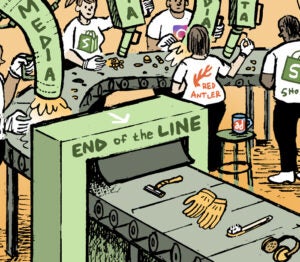 L’Oréal, owner of 28 beauty lines including Garnier, Maybelline and Lancôme, knows consumers are increasingly multibrand shoppers.
L’Oréal, owner of 28 beauty lines including Garnier, Maybelline and Lancôme, knows consumers are increasingly multibrand shoppers.
For years, it segmented customers simply as L’Oreal Paris shoppers or Maybelline brand loyalists. But new ecommerce channels create an abundance of choice, which makes consumers inherently less loyal.
“For the past 20 years, each brand did what they wanted to do,” Christophe Eymery, head of digital for L’Oréal Australia, said in an interview at Salesforce’s Connections event this week. “At this stage, the problem is avoiding marketing [silos to] become more streamlined. The direction and change is coming from the top.”
L’Oréal Australia aims to reach 2.5 million consumers by 2020, which is one reason why it’s standardizing on the Salesforce marketing and sales clouds to unite transactional and product-level data with marketing activity. The company also relies on data platform Datorama to analyze things like the impact of TV ad spend on search queries.
Although L’Oréal USA and Australia consolidate their agency relationships and work with one agency of record (it was DigitasLBI, but the $2.3 billion account is up for review) and one specialized search agency, Eymery said that following a recent regional restructure he now has three direct reports, including media, CRM and social media directors.
“There is a big movement internally for people from the digital side of business to cover the whole spectrum or marketing,” he said, noting the brand’s ambition to double its customer base in emerging markets and facilitate product innovation.
While L’Oréal’s agencies usually execute media buys, Eymery said the brand houses and supplies the data back to its agencies via platforms like Salesforce Marketing Cloud and Datorama.
Although L’Oreal continues to rely heavily on traditional media like TV and print magazines, Facebook is a big video distribution platform for the brand (second only to YouTube) and its No. 1 source for app downloads.
“We were a launch partner for Instagram ads in Australia,” Eymery said. “Facebook and Instagram are really interesting to us because there’s always a risk that as you increase impressions, people will feel pressured, but we’ve found beauty is very visual and we always look to add value to their feed.”
L’Oréal Australia also served as a launch partner for Twitter Amplify in Australia, a program allowing brands to sponsor pre-rolls against broadcaster content. L’Oréal increases its spend during red carpet events. For three days during the Cannes Film Festival, it bought keywords around festival conversations and served pre-roll video ads against content from publishers like E!
A big brand priority is getting smarter with capturing data and using it to strengthen direct-to-consumer relationships. While retailers like Walmart and Target historically own the customer relationships, L’Oréal primarily services the retailer as its distributor.
AdExchanger Daily
Get our editors’ roundup delivered to your inbox every weekday.
Daily Roundup
Mobile apps like Makeup Genius (which turns the smartphone into a mirror, allowing users to try on new products or scan bar codes for products for more info) are one way L’Oréal can foster a more direct-to-consumer relationship. More than 1.5 million people in the US have downloaded the app, along with 500,000 in Australia.
L’Oréal uploads data via Salesforce.com’s Journey Builder about people who trialed various makeup products in the app, then finds lookalikes who might be interested in similar products.
L’Oréal also augments point-of-sale data from its respective beauty counters with third-party insights from Macy’s (through shopper data firm dunnhumby) and regional department stores to find crossovers between people who, for instance, buy skin care and fragrance products.
“We’re trying to harness more data and information to acknowledge what happened in organic channels to maximize our buying efficiencies with publishers, so CRM helps us prioritize our paid media activities, ” Eymery said.
“Because our consumer division at L’Oréal does not have a direct-to-consumer platform, we don’t logistically have the ability to sell to customers especially in small batches, so we’re trying to give consumers the option to shop the retailers they want.”













